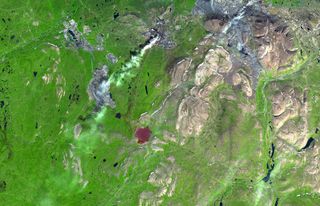The River Are Running Again Lyrics
Russian River Runs Blood-red

A river in Russia has turned bright red, and pictures of the spectacle are circulating on social media.
The Siberian Times reported on Sept. 7 that the Daldykan River near the city of Norilsk had turned the color of claret, with locals pointing fingers at the nearby Nadezhda Metallurgical Plant, owned by the company Norilsk Nickel. In fact, a cleaved pipeline at the institute may be the culprit, according to a statement from the Russian Ministry of Natural Resources. The visitor, however, has denied whatsoever accidental discharge of pollutants. The company did non respond to Alive Scientific discipline's request for comment.
Norilsk Nickel does have a history of environmental problems, withal. In 2014, a company institute in Harjavalta, Finland, released 66 metric tons (72.vii U.S. tons) of nickel into the Kokemäenjoki River, sending nickel levels soaring far above condom limits. Finland Times reported at the time that levels in the river in the city of Pori reached 530 micrograms per liter. Safe drinking levels are below 20 micrograms per liter. The water in the Kokemäenjoki did not plough crimson, however. [Photos: The Strangest Places on World]
Norilsk is no stranger to struggles with pollution. In 2007, the city appeared on the tiptop 10 list of worst-polluted places on Globe, in a report released by the ecology group the Blacksmith Establish. The metropolis also consistently ranks equally the about-polluted city in Russian federation, according to government statistics.
According to the Blacksmith Found, Norilsk is home to the world's largest heavy metals smelting complex, and is the source of all this pollution. The soil around Norilsk has been so polluted that, according to NASA, it tin can actually be mined: It contains economically useful levels of palladium and platinum. Each twelvemonth, the smelters release about two tons of sulfur dioxide into the air above Norilsk — emissions that cause acid rain and have reached as far as 124 miles (200 kilometers) abroad, according to a 2003 report in the Russian Periodical of Ecology.
A 1995 review of research on public health in Norilsk, published in the journal Science of the Total Environment, found higher-than-boilerplate rates of cancer and cancer deaths, higher-than-average rates of premature births and high rates of respiratory illness in children. A 1985 dissertation written report found that children living closest to the nickel plant were 1.5 times more likely to have respiratory, ear, nose or throat diseases than those living further away.
While information technology remains unclear what caused the Daldykan River to flow crimson, mining and industrial processes have caused similar problems in other places. In 2015, wastewater from a long-abased mine in Colorado flowed into the Animas River, turning the water a striking orange color.
Red waters aren't ever a sign of doom and gloom. This summer, Islamic republic of iran'southward Lake Urmia turned from greenish to blood red as a effect of microorganisms that thrive on salt and light. The Blood Falls of Antarctica get their scarlet hue from bacteria hiding out in the briny water beneath the glacier in that location. Salt-loving archaea microbes plough Utah's Swell Table salt Lake a rosy pink.
Original article on Alive Science.
Source: https://www.livescience.com/56014-why-russian-river-turns-blood-red.html

0 Response to "The River Are Running Again Lyrics"
Postar um comentário